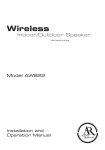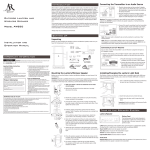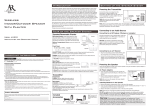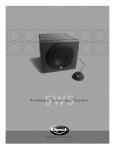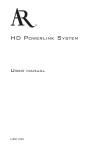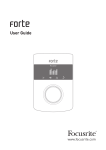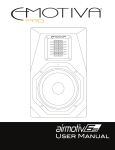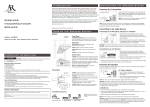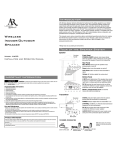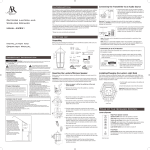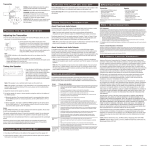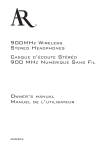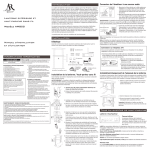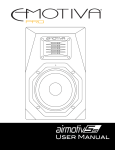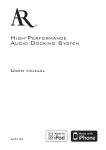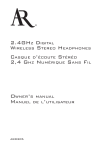Download Acoustic Research AW877 Speaker System User Manual
Transcript
Wireless Stereo Speakers with auto-tuning Model AW877 Installation and Operation Manual Important Information CAUTION RISK OF ELECTRIC SHOCK. DO NOT OPEN. Caution: To reduce the risk of electric shock, do not remove cover (or back). No user serviceable parts inside. Refer servicing to qualified service personnel. WARNING: To reduce the risk of fire or electric shock, do not expose this product to rain or moisture. The apparatus shall not be exposed to dripping or splashing. No objects filled with liquids, such as vases, shall be placed on the apparatus. FCC Statement This equipment has been tested and found to comply with the limits for a Class B digital device, pursuant to part 15 of the FCC Rules. These limits are designed to provide reasonable protection against harmful interference in a residential installation. This equipment generates, uses, and can radiate radio frequency energy and, if not installed and used in accordance with the instructions, may cause harmful interference to radio communication. However, there is no guarantee that interference will not occur in a particular installation. If this equipment does cause harmful interference to radio or television reception, which can be determined by turning the equipment off and on, the user is encouraged to try to correct the interference by one or more of the following measures: • Reorient or relocate the receiving antenna. • Increase the separation between the equipment and receiver. • Connect the equipment into an outlet on a circuit different from that to which the receiver is connected. • Consult the dealer or an experienced radio/ TV technician for help. FCC Regulations state that unauthorized changes or modifications to this equipment may void the user’s authority to operate it. Product Information Keep your sales receipt to obtain warranty parts and service and for proof of purchase. Attach it here and record the serial and model numbers in case you need them. These numbers are located on the product. Model No.:_ _______________________________ Purchase Date:_ ____________________________ Dealer/Address/Phone:______________________ Important Safety Instructions 1. 2. 3. 4. 5. 6. 7. 8. 9. 10. 11. Read these instructions. Keep these instructions. Heed all warnings. Follow all instructions. Do not use this apparatus near water. Clean only with dry cloth. Do not block any ventilation openings. Install in accordance with the manufacturer’s instructions. Do not install near any heat sources such as radiators, heat registers, stoves, or other apparatus (including amplifiers) that produce heat. Protect the power cord from being walked on or pinched particularly at plugs, convenience receptacles, and the point where they exit from the apparatus. Unplug this apparatus during lightning storms or when unused for long periods of time. Refer all servicing to qualified service personnel. Servicing is required when the apparatus has been damaged in any way, such as power-supply cord or plug is damaged, liquid has been spilled or objects have fallen into the apparatus, the apparatus has been exposed to rain or moisture, does not operate normally, or has been dropped. Care and Maintenance • Always use a soft cloth to clean the speakers and transmitter. Never use any product containing alcohol or other solvents as they may damage the surface. • Use caution when plugging the power transformers in an AC outlet to avoid the risk of electric shock. • Never expose the speakers or transmitter to rain or moisture as this may cause damage. If the speakers are used outside on a deck or patio, make sure you take them indoors in the event of a rainstorm to prevent possible damage. • Do not operate or store the system in extreme temperatures (below 32ºF/0ºC and above 122ºF/50ºC). Table of Contents Introduction........................................................................................1 Tour of the Speaker System..............................................................2 Connecting the Speaker System.......................................................4 Adjusting the Transmitter.................................................................6 Tuning the Speakers...........................................................................6 Turning the Speakers Off..................................................................7 More Helpful Information................................................................8 Troubleshooting..................................................................................9 Specifications....................................................................................10 12 Month Limited Warranty...........................................................10 Introduction AR’s Wireless Stereo Speakers eliminate the hardest part of adding speakers to your home—running and hiding hundreds of feet of speaker wire. The AR Wireless Speaker System’s RF signal travels with ease through walls, floors, ceilings and other obstacles, delivering high-quality sound virtually anywhere inside the house or out. With drift- and static-free reception along with outstanding range—up to 250 feet*—the possibilities for enjoying your AR Wireless Speaker System are nearly unlimited. The AR Wireless Speaker System is compatible with most audio sources, such as TVs, DVD players, VCRs, A/V receivers/amps, stereos, computers, and portable devices (CD players, cassette players, MP3s etc.). This manual covers various connection options and detailed operating instructions for making the AR Wireless Stereo Speakers a valued part of your lifestyle. If, after having reviewed the instructions, you have any questions, please call toll-free 1-800-732-6866 or visit www.araccessories.com. *Range may vary according to environment. Tour of the Speaker System Speaker Front View Power/Volume/Scan control turns the speaker on, adjusts the volume level and rescans for the transmitter’s signal; press and hold to turn the speaker off CHRG. indicator lights red when the speaker is turned off and rechargeable batteries are loaded STDBY./TUNED indicator lights red when the speaker is first powered on; it turns blue when the speaker is tuned to the transmitter Speaker Back View Carrying handle Battery Compartment Cover— remove to install 8 C-cell batteries L/Mono/R switch determines if the speaker plays the left or right track in a stereo pair, or plays sound in mono as a stand-alone speaker Speaker power input jack receives the small round end of one of the included 18V 700mA AC power adapters Transmitter Front View Transmission indicator lights blue when the audio is present and the transmitter is broadcasting Transmitter Back View Channel select switch lets you find the best transmission frequency for your environment Built-in audio input cable connects to your sound source using one of the connection options shown on the next pages Transmitter power input jack receives the small round end of the included 12V 100mA AC power adapter Included Accessories /4” headphone adapter (3.5mm to 6.3mm) 1 “Y” adapter cable Speaker AC/DC 18V 700mA adapter (x2) Transmitter AC/DC 12V 100mA adapter Note: The power units are intended to be correctly oriented in a vertical or floor mount position. Connecting the Speaker System Powering the Transmitter Connect the small, round plug from the transmitter AC power adapter to the transmitter’s power input jack. Plug the other end of the transmitter AC power adapter into any standard 120V AC wall outlet. Note: Be sure to use the AC power adapter rated 12V DC 100 mA. Transmitter 120V AC wall outlet AC Power Adapter Note: There is no transmitter ON/OFF switch. The transmitter is designed to be left plugged in and powered at all times. If you will not be using the AW877 for an extended period of time, unplug the transmitter AC power adapter. Connecting to an Audio Source Connecting to an A/V Receiver Transmitter A/V Receiver Audio Output “Y” adapter cable Audio Input Cable Connecting to a TV TV Transmitter Audio Output “Y” adapter cable Audio Input Cable 1.Connect the included “Y” adapter cable to the 3.5mm mini-plug cable coming out of the transmitter. 2. Connect the left (white) and right (red) audio plugs on the ”Y” adapter cable to the corresponding left and right audio outputs of your A/V receiver, amp or other audio source. 1.Connect the included “Y” adapter cable to the 3.5mm mini-plug cable coming out of the transmitter. 2.Connect the left (white) and right (red) audio plugs on the “Y” adapter cable to the corresponding left and right audio outputs on the TV. Connecting to a Stereo or Computer Transmitter Stereo Audio Input Cable 1/4” headphone adapter Plug the cable coming out of the transmitter into the headphone output of your stereo or the audio output jack on your computer. Use the included 1/4” headphone adapter to convert the 3.5mm plug to a 1/4” plug as needed. Warning: This product is designed to work with line level outputs or headphone outputs only. DO NOT connect it directly to speaker outputs as it will permanently damage the transmitter. Powering the Speakers There are two options to power your wireless speakers: using the included AC power adapters or using 8 C-cell batteries per speaker (not included). AC Power Adapters 1. Turn the speaker volume down by rotating the Power/Volume/Scan control on the front of the speaker all the way to the left. Speaker AC Power adapter 120 V AC Wall Outlet 2.Insert the small, round plug from the speaker AC power adapter into the speaker power input jack. 3.Plug the other end of the speaker AC power adapter into any standard 120V AC wall outlet. Note: Be sure to use the speaker AC power adapter rated 18V DC 700 mA. Warning: This product is not water resistant. To avoid electrical shock, it should not be used near water sources if powered with the AC adapter. Never submerge in water. C-cell Batteries 1.Turn the speaker volume down by rotating the Power/Volume/Scan control on the front of the speaker all the way to the left. 2. Remove the battery compartment cover on the back of the speaker. 3. Insert eight (8) C-cell batteries (not included) into the speaker following the polarity (”+” and “-”) as diagrammed inside the battery compartment. 4.Replace the battery compartment cover on the back of the speaker. Important: If you are using rechargeable batteries NiMH or NiCd, the batteries will charge when the speaker is powered with the AC power adapter. DO NOT power the speaker with the AC power adapter if you installed alkaline or other non-rechargeable batteries – this could cause the batteries to leak, which would damage the speaker. DO NOT mix batteries with different chemistry types (for example, a zinc battery with an alkaline battery). DO NOT mix new and used batteries. DO NOT leave batteries installed in the product when not in use for long periods. Always remove old, weak or worn-out batteries promptly and recycle or dispose of them in accordance with local and national regulations. Adjusting the Transmitter 1. Turn on your audio source (for example, A/V receiver, TV, stereo, etc.) and play music at a normal listening volume. Transmitter Back View Built-in audio input cable Transmitter power input jack 2. Set the channel select switch on the back of the transmitter to one of the transmitter’s three broadcast frequencies: 1, 2 or 3. If you experience poor reception or interference, try choosing a different frequency by moving the channel select switch to another position. Channel select switch Transmitter Front View When the transmitter is receiving an audio signal and is ready, the light on its front turns blue. Note If the light on the front of the transmitter does not turn on, please check the following: Transmission Indicator Light - Confirm the transmitter AC power adapter is securely connected. - Confirm the cable from the transmitter is securely connected to the audio source output (TV, A/V receiver, etc.). Tuning the Speakers Standby/ Tuned Indicator Power/Tuning/ Volume Control Speaker Front View 1.Press the Power/Volume/Scan control on each speaker to turn it on. The STDBY./TUNED light illuminates red while the speaker is tuning to the transmitter. The STDBY./TUNED light turns blue when the speaker is tuned to the transmitter—you should hear sound coming from the speaker now. Note: If the speaker is not tuned or if the transmitter is not connected properly, the STDBY./TUNED indicator will not turn from red to blue. If this occurs, please see the troubleshooting section of this manual. 2. Adjust the volume on each speaker as desired. 3. Set up each speaker for mono or stereo operation. Speaker Power Input Jack Left/Mono/Right Slide Switch Speaker Back View a) Monaural operation: The monaural mode (MONO) is recommended when using single speakers separately. For monaural operation, set the L/MONO/R switch to “MONO” on each speaker. b) Stereo operation: Set the L/MONO/R switch to “L” on the speaker located to the left from the listener, and set the other speaker to the “R” position. Notes: Each speaker automatically retunes if it loses the transmitter’s signal. You can also press the Power/ Volume/Scan button on the front of the speaker to retune the speaker at any time. The transmitter turns off automatically if there is no audio signal present for a prolonged period. Interference in the form of static and/or distortion can sometimes be heard. If this occurs, confirm the transmitter/speaker adjustments and indicators. If the problem persists, refer to the Troubleshooting section of this manual. Turning the Speakers Off 1.Press and hold the Power/Volume / Scan control to turn the speaker off. 2.Confirm that the speaker is off by verifying that the STDBY./TUNED indicator is no longer illuminated. The speaker will automatically charge rechargeable batteries (NiMH or NiCd only) when the batteries are installed and the speaker is plugged in with the AC power adapter. The CHRG. indicator on the front of the speaker will illuminate. Warning: DO NOT power the speaker with the AC power adapter if you installed alkaline or other non-rechargeable batteries – this could cause the batteries to leak, which would damage the speaker. More Helpful Information About Fixed-Level Audio Outputs A fixed-level, or line-level audio output is considered ideal since it provides an audio signal unchanged by adjustments to the audio source volume control. Hint: Fixed-level audio outputs from stereo receivers/amps will typically be designated as Tape, Tape 1, and Tape 2 outputs, or VCR audio output connections These outputs are frequently marked on A/V equipment as ‘TAPE OUTPUT,’ ‘TAPE OUT,’ ‘TAPE REC, or ‘TAPE RECORD or REC OUT.’ Please note: Jacks labeled PHONO, CD, LD, DVD or tape or VCR playback (PB) are INPUTS and will not work with the transmitter. Fixed-level outputs from TVs are usually marked as ‘Constant,’ ‘Fixed,’ or ‘Select.’ If they are not marked as such, they are probably variable outputs (see “About VariableLevel Audio Outputs” on the next page). Outputs from VCRs are almost always fixed. Hint: When connecting to the audio outputs of a VCR, remember that the VCR must be playing a tape or showing a TV channel for sound to be produced. Hint: If your VCR (or other audio source with RCA jacks) only has a single audio output, you will need another RCA “Y” cable. It differs from the “Y” Cable Adapter included with this speaker. It will have a single male RCA plug and 2 female RCA jacks. Connect the dual RCA plugs from the included “Y” cable adapter to the 2 female RCA jacks on the second “Y” cable, and then connect the single male RCA plug of the second “Y” cable to the single audio output of the VCR. About Variable-Level Audio Outputs: A variable-level output, such as a headphone jack or certain RCA-type outputs, provides an audio signal that changes with the volume level set on the audio source. As the volume of the audio source is adjusted up and down, so is the audio signal strength sent to the transmitter. This can affect the quality of sound generated by the speaker, and may require an adjustment of the volume level of the audio source to produce a signal strong enough for the transmitter. Hint: On most bookshelf-type or compact stereo systems, inserting a headphone plug into the headphone jack results in automatic cutoff of the regular, or hard-wired speakers. Hint: Most TVs, regardless of age or price, have variable outputs. If you are unsure which of your TV audio outputs is fixed, refer to the TV instruction manual. Some TVs have outputs that can switch between variable and fixed. When given a choice, fixed is always recommended. Troubleshooting The following troubleshooting guide takes you through some of the more common problems associated with the installation and/or operation of a wireless system. If the problem persists, please call toll-free at 1-800- 732-6866 or visit www.araccessories.com. Issue: Cause and solution: No sound • Check that the transmitter AC power adapter is fully inserted into the wall outlet and the power cord from the AC adapter is firmly connected to the transmitter power input jack. • Confirm that the speakers are turned on and tuned to the transmitter— the STDBY./TUNED indicator light on the front of each speaker should be illuminated blue. • If you’re using the power adapters, confirm that all three (for both speakers and for the transmitter) are fully inserted into their wall outlets and the adapter power cords are firmly connected to the power input jacks on the transmitter or speaker. or • If you’re using batteries, check that they are fresh and inserted with correct polarity (+, –). • Check that the audio source component (stereo, TV, etc.) is turned on and transmitting sound as it normally should. • Check that the speaker volumes are turned up. • If you are using a Tape 2 Monitor output from your receiver/amp as the audio output, check that you have pressed the Tape Monitor/Tape 2 button on the front of the receiver. This will turn on the Tape 2 outputs, which may not have been active. Issue: Cause and solution: No sound/ distortion/ static • When using battery power, make sure the batteries are fresh and replace if necessary. • Check that the speaker STDBY./TUNED indicator is illuminated blue. • Change the position of the channel select switch (1, 2 or 3) to change the operating frequency. The speaker will detect the loss of signal and retune automatically. You can also press the Power/Volume/Tuning control once to make the speaker retune. • Change the location of the transmitter. Place it as high and away from obstructions as possible. Avoid placing the transmitter directly on top of or behind a TV. • Move the transmitter and speaker closer together. Sending the signal through certain materials, such as glass, tile, and metal, can decrease the effective transmitting distance of the system. Specifications Transmitter Speaker • Omni-directional 900MHz broadcast • Effective transmitting range: up to 250 ft. (80m)* • Phase-locked loop circuitry (PLL) • Automatic level control (ALC) • 3 selectable broadcast frequencies • Stereo audio input • Push-button, auto-lock tuning • 2-way acoustic design: 2” dome tweeter, 5” woofer • 7.5 Watt RMS internal amplifier (each speaker) • Frequency response: 20Hz - 20kHz • Left/Mono/Right switch • Operates using supplied AC adapters or eight (8) C-cell batteries (each speaker, not included) • Dimensions: 10”H x 6 1/4””W x 7”D • Dimensions: 4”H x 4 3/4”W x 2 3/4”D *Maximum range; results may vary according to environment. 12 Month Limited Warranty Audiovox Electronics Corporation (the “Company”) warrants to the original retail purchaser of this product that should this product or any part thereof, under normal use and conditions, be proven defective in material or workmanship within 12 months from the date of original purchase, such defect(s) will be repaired or replaced (at the Company’s option) without charge for parts and repair labor. To obtain repair or replacement within the terms of this Warranty, the product along with any accessories included in the original packaging is to be delivered with proof of warranty coverage (e.g. dated bill of sale), specification of defect(s), transportation prepaid, to the Company at the address shown below. Do not return this product to the Retailer. This Warranty is not transferable and does not cover product purchased, serviced or used outside the United States or Canada. The warranty does not extend to the elimination of externally generated static or noise, to costs incurred for the installation, removal or reinstallation of the product. The warranty does not apply to any product or part thereof which, in the opinion of the company, has suffered or been damaged through alteration, improper installation, mishandling, misuse, neglect, accident or exposure to moisture. This warranty does not apply to damage caused by an AC adapter not provided with the product, or by leaving non-rechargeable batteries in the product while plugged into an AC outlet. THE EXTENT OF THE COMPANY’S LIABILITY UNDER THIS WARRANTY IS LIMITED TO THE REPAIR OR REPLACEMENT PROVIDED ABOVE AND, IN NO EVENT, SHALL THE COMPANY’S LIABILITY EXCEED THE PURCHASE PRICE PAID BY PURCHASER FOR THE PRODUCT. This Warranty is in lieu of all other express warranties or liabilities. ANY IMPLIED WARRANTIES, INCLUDING ANY IMPLIED WARRANTY OF MERCHANTABILITY OR FITNESS FOR A PARTICULAR PURPOSE, SHALL BE LIMITED TO DURATION OF THIS WARRANTY. ANY ACTION FOR BREACH OF ANY WARRANTY HEREUNDER, INCLUDING ANY IMPLIED WARRANTY, MUST BE BROUGHT WITHIN A PERIOD OF 24 MONTHS FROM THE DATE OF ORIGINAL PURCHASE. IN NO CASE SHALL THE COMPANY BE LIABLE FOR ANY CONSEQUENTIAL OR INCIDENTAL DAMAGES WHATSOEVER. No person or representative is authorized to assume for the Company any liability other than expressed herein in connection with the sale of this product. Some states/provinces do not allow limitations on how long an implied warranty lasts or the exclusion or limitation of incidental or consequential damage so the above limitations or exclusions may not apply to you. This Warranty gives you specific legal rights and you may also have other rights which vary from state/province to state/province. U.S.A.:Audiovox Electronics Corp., 150 Marcus Blvd., Hauppauge, New York 11788 CANADA: Audiovox Return Center, c/o Genco, 6685 Kennedy Road, Unit 3, Door 16, Mississauga Ontario L5T 3A5 ©2007 AEC, 150 Marcus Blvd. Hauppauge, NY 11788 Trademark(s) ® Registered www.araccessories.com MADE IN CHINA AW877 US IB 01 Addendum to the Installation Manual Accessing the Speaker Battery Compartments There are two options to power your wireless speakers: using the included AC power adapters or using 8 C-cell batteries per speaker (not included). The Installation and Operation Manual takes you through the steps to do both on page 5. The Installation and Operation Manual does not include instructions for accessing the battery compartment on each speaker. Speaker Back To remove a speaker battery compartment cover: 1. Lay the speaker gently on its front. 2. Use a Phillips-head screwdriver to loosen the compartment cover screws. 3. Hold the battery compartment cover and turn the speaker over. The screws should fall out. If they don’t, lay the speaker on its front again and loosen the screws a little more. Cover Screws Important: Don’t lose the screws! You’ll need them to put the battery compartment cover back on. 4. Put the speaker on its front again. Remove the battery compartment cover. 5.Insert eight (8) C-cell batteries (not included) in the speaker following the polarity (+ and –) diagram inside the compartment. Speaker Battery Compartment Cover To replace the speaker battery compartment cover: 1. Put the battery compartment back in place. 2. Put the screws back in the holes on the battery compartment cover. Use a Phillips-head screwdriver to tighten the compartment cover screws. AW877_TIS2_00













